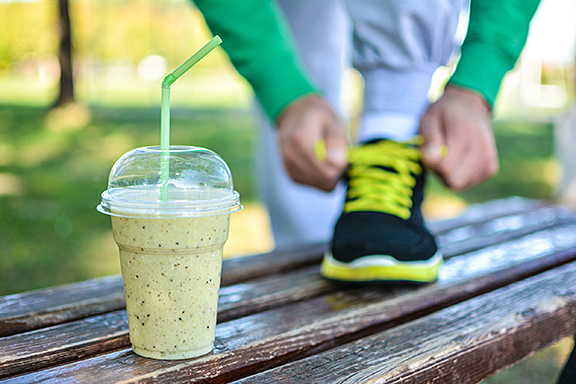Does Exercise Influence Healthy Eating Habits?

What foods do you reach for after a spin class, an hour of weights or an evening run? Does a salad sound good to you or do you crave fast food, chips and a chocolate bar
Working out means working up an appetite, right? You will definitely notice that your stomach’s growling more frequently after the first few weeks of a new fitness routine. The obvious reason for an increase in appetite is due to your body’s need to replenish what was used during your workout.
Most workouts contain some component of glycogen burning. Glycogen is the body’s stored source of carbohydrates. So, during a workout, when your glycogen stores are depleted, your body starts to utilize more of the sugar in your blood for energy. Once all the stored glycogen is depleted, you will feel tired, fatigued and your exercise performance will suffer. As a result, your brain starts getting signals that it’s time to fuel-up. This is when we often crave carbohydrates (the unhealthy kind) or sweets to compensate for the loss in blood sugar level.
It can be difficult to eat healthy when calorie-dense, nutrient-poor foods are heavily marketed and easily accessible. It’s safe to say there is no shortage! With limited time to shop, buy and cook healthy meals, every day is an uphill battle for most of us! Consequently, we often buy cheap, heavily processed, and overall unhealthy foods out of convenience. Unfortunately, over time this will result in negative health consequences.
It can be difficult to eat healthy when calorie-dense, nutrient-poor foods are heavily marketed and easily accessible. It’s safe to say there is no shortage! With limited time to shop, buy and cook healthy meals, every day is an uphill battle for most of us! Consequently, we often buy cheap, heavily processed, and overall unhealthy foods out of convenience. Unfortunately, over time this will result in negative health consequences.
When we crave unhealthy or out-of-the-ordinary foods, it’s an indication that something is missing from our diets. It can also be a sign that we are deficient in some of the necessary essential nutrients our body needs to function properly. Though this may explain a lot, there are other factors to consider. For example, how does exercise effect our food choices? Does exercise influence healthy eating habits? Does sedentary behavior and limited physical activity encourage unhealthy eating habits?
Recent research suggests there’s a single best place to begin. According to a study published in the International Journal of Obesity, starting an exercise regimen may inspire you to eat healthier. For the study, researchers recruited more than 2,500 college students who said they did not follow any kind of diet or exercise for more than 30 minutes a week. The students were put on a 15-week aerobic exercise plan that involved doing guided cardio for 30 to 60 minutes, three times a week. All participants were told not to change their eating habits. Heart rate data was recorded for all workout sessions to gauge aerobic intensity and to ensure that participants reached at least 65% of their maximum heart rate.
To assess dietary choices, researchers gave participants a survey prior to the 15-week exercise program. Participants ranked how often they consumed 102 different food items on a scale of one to nine, where one meant never and nine meant they consumed the food on an everyday basis. This same survey was given again after the study period to evaluate changes in healthy eating habits.
Aerobic exercise could establish healthy eating habits
Research found that the approximately 2,000 participants who stuck with the exercise plan were more likely than their counterparts to make healthier food choices all on their own. After the 15-week exercise period, many of the participants started eating more nutritious foods, like fruits, vegetables, lean meats, fish and nuts. They also consumed fewer fried foods, soda and snack foods. Researchers found that the more a partaker exercised, the more their diet had a tendency to improve.
Longer exercise duration was associated with a decrease in preference for foods characteristic of the standard western diet, such as red meat, fried foods and snack foods. In addition, high-intensity exercise was associated with an increase in preference for healthy foods. Overall, compliance with the exercise program was associated with a transition towards eating healthier overall.
Furthermore, research has shown that positive results fuel adherence and persistence and other changes psychologically. Along with mitigating the negative effects of chronic stress on the mind and body, habitual exercise has been proven to improve mental health. Since exercise releases feel-good endorphins (natural cannabis-like brain chemicals and other natural brain chemicals), many experts believe routine exercise is as powerful in treating anxiety and mood disorders as antidepressants.
Plenty of research also suggests that exercise can change brain function, and this rewiring may be behind the urge to make healthier food choices. You may find yourself saying, ‘Wow, my pants feel looser.” This of course will encourage more effort into making healthy food choices and improved eating habits.
In Conclusion:
Starting a journey to get healthy can be a daunting endeavor. It can seem impossible to be active, eat better, sleep more, stay hydrated and do all of the things we need to do, all at once.
Starting a diet can be the hardest task of it all. Most of us feel deprived from the get-go. Instead of making drastic dietary changes, try adding physical activity to your life, and the consequent changes may create significant changes in the way you eat.
Does exercise influence healthy eating habits? Starting an exercise routine certainly can’t hurt! It can be a much easier path than going on a restrictive diet and it’s good for your mind, body and soul. Think of physical activity as adding something with a good health message to your life! This is a gift you’re giving yourself that will result in significant health changes today, tomorrow and for years to come. Good luck to you!









